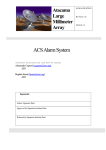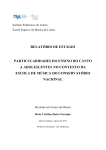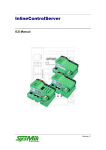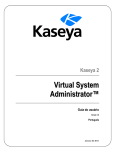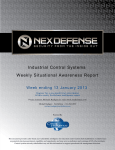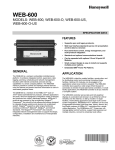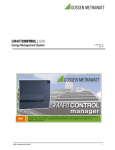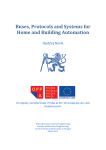Download "user manual"
Transcript
EEPOS ● EEPOS automation and energy management platform - Specification Page 1 of 34 Specification of EEPOS automation and energy management platform Authors: Birthe Klebow DERlab Arturs Purvins DERlab Birthe Klebow DERlab Kaspar Pae YIT Roland Kopetzky ENO Kalevi Pira VTT Veijo Lappalainen VTT Disclaimer The information in this document is provided as is and no guarantee or warranty is given that the information is fit for any particular purpose. The user thereof uses the information at its sole risk and liability. The document reflects only the author’s views and the Community is not liable for any use that may be made of the information contained therein. 2013-05-17 EEPOS ● EEPOS automation and energy management platform - Specification Page 2 of 34 Table of contents 1. Publishable executive summary .......................................................................... 3 2. Introduction............................................................................................................ 4 2.1 Purpose and target group ........................................................................................ 4 2.2 Contributions of partners ......................................................................................... 4 2.3 Baseline .................................................................................................................. 5 2.4 Relations to other activities ...................................................................................... 5 3. Architecture of the NEMS platform ...................................................................... 6 3.1 Envisioned NEMS platform architecture .................................................................. 6 3.2 Role of OGEMA, required hardware and operating system ..................................... 7 3.3 Interfaces of the EEPOS NEMS .............................................................................. 9 3.3.1 Provisional data exchange ....................................................................................... 10 3.3.2 Finnish Demonstration (T5.1) .................................................................................. 12 3.3.3 German Demonstration (T5.2) ................................................................................. 12 3.3.4 EEPOS-ICT .............................................................................................................. 16 4. NEMS requirements ............................................................................................ 18 4.1 Stakeholder support services ................................................................................ 18 4.1.1 Finnish demonstration (T5.1) ................................................................................... 20 4.1.2 German demonstration (T5.2).................................................................................. 20 4.1.3 EEPOS-ICT .............................................................................................................. 21 4.2 Functional capabilities ........................................................................................... 22 4.2.1 Data management functions .................................................................................... 22 4.2.2 Energy management functions ................................................................................ 22 4.2.3 Finnish Demonstration (T5.1) .................................................................................. 25 4.2.4 German Demonstration (T5.2) ................................................................................. 25 4.2.5 EEPOS-ICT .............................................................................................................. 26 4.3 Use cases ............................................................................................................. 26 4.3.1 Data management: NEMS- BEMS/DER/load .......................................................... 27 4.3.2 Energy management in NEMS ................................................................................ 28 4.4 Performance criteria .............................................................................................. 29 4.4.1 Finnish Demonstration (T5.1) .................................................................................. 30 4.4.2 German Demonstration (T5.2) ................................................................................. 30 4.4.3 EEPOS-ICT .............................................................................................................. 31 5. Conclusions ......................................................................................................... 32 5.1 Summary of achievements .................................................................................... 32 5.2 Relation to continued developments ...................................................................... 32 5.3 Other conclusions and lessons learnt .................................................................... 32 6. Acronyms and terms ........................................................................................... 33 7. References ........................................................................................................... 34 2013-05-17 EEPOS ● EEPOS automation and energy management platform - Specification Page 3 of 34 1. PUBLISHABLE EXECUTIVE SUMMARY This report proposes the provisional platform architecture of the EEPOS neighbourhood energy management system (NEMS). The NEMS platform is a hardware and software base on which energy management in a neighbourhood can be developed and performed. The EEPOS NEMS will perform energy management in a neighbourhood supportive way through communication with the Energy Management Systems of the Buildings within the neighbourhoods (BEMSs), with Distributed Energy Resources (DER) and loads on the neighbourhood level (other than households, e.g. street lighting), as well as with the EEPOS Information and Communication Technologies (ICT) platform. ICT platform is a mediator between NEMS and external data sources like predicted electricity price profile and weather forecast required for efficient neighbourhood energy management. The EEPOS NEMS will be developed basing on the OGEMA framework. The EEPOS NEMS platform specification is based on the overall system specification described in Deliverable 1.3 and designed in a way which supports the EEPOS application scenarios (Task 1.1), potential stakeholder needs (Task 1.2) and business models (Task 1.4). The main functions of the EEPOS platform will be developed for future electricity systems with high deployment of DER and are as follows: Maximum utilisation of DER in neighbourhood level grids Provision of load shifting services to electricity market Optional: Distribution grid support (congestion management, peak load shaving, voltage management, phase balance) The main instrument for performing these tasks will be load shifting within the neighbourhood. The NEMS platform should provide the necessary communication among electricity system stakeholders in order to ensure optimal utilisation of controllable loads leading to efficient implementation of the EEPOS tasks. Communication interfaces are described between the following parts of EEPOS platform. NEMS – BEMS/DER/load NEMS – ICT-platform Furthermore, the following potential stakeholder support services are identified and are mainly based on software architecture: Plug & play Human Computer Interface (HCI) Modularity Application support Software maintenance Continuous operation Easy programming Persistent storage of data and application settings User Administration and data security Application scenarios and business models are addressed in functional capabilities which NEMS should consider: Data management functions such as data collection, data transfer and calculation Energy management functions such as high DER utilisation through load shifting In addition, properties of specific energy monitoring/management systems on household level are described. In the Finnish and German field tests (WP5), JACE (Java Application Control Engine) and Smartbox systems, respectively, will be used in households. 2013-05-17 EEPOS ● EEPOS automation and energy management platform - Specification Page 4 of 34 2. INTRODUCTION The main task of the EEPOS energy management system is to manage energy loads and generators in a neighbourhood electricity system in a cost effective way according to the following priorities. Maximum utilisation of Distributed Energy Resources (DER) in neighbourhood level grids. Energy produced within the neighbourhood shall be consumed locally. Among others, this will be achieved by shifting of loads from times of low to times of high local energy production Provision of load shifting services that could be utilized by an electricity market Optional: Distribution grid support (congestion management, peak load shaving, voltage management, phase balance) Following these priorities the EEPOS Neighbourhood Energy Management System (NEMS) may reduce the overall electricity generation costs introducing neighbourhood load shifting services to the electricity market and the neighbourhood grid. In other words, the aim of the NEMS is to provide a cost effective support to future electricity systems with high deployment of DER. Such management may be required in the future electricity systems. The management algorithms will be discussed and defined in Task T2.3. These algorithms will be developed in the OGEMA software platform on neighbourhood level. Optional service such as distribution grid support may increase the feasibility of EEPOS platform and may support indirectly one of the main project objectives: reduction of energy losses. However it may be not addressed in laboratory and field tests, or will be addressed partly. 2.1 Purpose and target group The purpose of this report is to develop a provisional specification of the EEPOS neighbourhood automation and energy management system platform: NEMS platform. This platform should be in a line with the application scenarios for the EEPOS platform studied in Task 1.1. The target group of this report includes the EEPOS project consortium and all the relevant stakeholders identified in Task 1.2. The report describes in details the design process of the NEMS platform architecture addressing the role of NEMS and data communication ways. Possible benefits for the target stakeholders will be analysed in detail in the business models developed in Task 1.4. 2.2 Contributions of partners Contribution of each partner in this report is listed in Table 1. Table 1. Contribution of partners in this report Partner Section DERlab YIT VTT ENO 1-7 3.3.2, 4.1.1, 4.2.3, 4.4.1, 6, 7 2.3, 3.3.4, 4.1.3, 4.2.5, 4.4.3, 6, 7 3.3.3, 4.4, 4.1.2, 4.2.4, 4.4.2, 6, 7 2013-05-17 EEPOS ● EEPOS automation and energy management platform - Specification Page 5 of 34 2.3 Baseline Automation of local electricity grids is one of the steps towards ‘smart’ grids. Automation has already started by installing smart meters, which frequently send information about energy consumption in households to, e.g. energy service providers. Moreover, bidirectional data communication allows ‘smart’ meters to send information about the current electricity price to the end-user in a way giving the end-user the opportunity to maintain his energy consumption (load shifting) in a cost effective way. An extensive summary about on-going research and technological development (RTD) projects is included in the state-of-the-art report of the EU FP7 IREEN road-mapping project (http://www.ireenproject.eu/wp-content/uploads/2012/09/IREEN_D2.2.1-Report-on-state-ofthe-art.pdf). Intensive standardisation is going on, covering areas of smart grids, smart metering, energy management etc. on European and international level. Relevant standards, existing and under development, are e.g. CIM, IEC 61850, OpenADR and ASHRAE SPC 201P. Description of use cases for the EEPOS project will be tentatively based on the Use Case Template provided by CEN/CENELEC/ETSI. The EEPOS energy management platform will provide a contribution to the on-going automation of distribution grids. It will perform energy management within a neighbourhood in a semi-centralised way, where the energy management will be performed on two levels: neighbourhood and household. Centralised (neighbourhood) management is performed in order to enable efficient utilisation of local DER and support the local electricity grid. Thus, the central management will support the decentralised management systems (in households) with additional information. In such a way household management systems are involved also in neighbourhood management. Management on household level, in turn, allows maximizing the utilisation of flexible demand resources in the neighbourhood since it has direct access to controllable household appliances. Such semi-centralised management combines benefits of centralised and decentralised systems. This combination may increase the feasibility of ‘smart’ grids. 2.4 Relations to other activities The specification of the NEMS platform architecture is mainly based on the Work Package 1, Task 1.3: ‘Overall architecture specification’. Other tasks of Work Package 1 are closely related and are in a line with the architecture specification: Application scenarios (Task 1.1) Stakeholders requirements (Task 1.2) Business models (Task 1.4). This NEMS platform architecture specification report will be used further for the implementation of the NEMS platform and the other tasks of WP 2: Platform specification and implementation (Task 2.1) Neighbourhood energy grids information models (Task 2.2) Supervisory and predictive controls (Task 2.3) The NEMS developed in WP2 will be tested in the laboratory prototype (T4.2) and be employed and validated in the field tests (WP5). 2013-05-17 EEPOS ● EEPOS automation and energy management platform - Specification Page 6 of 34 3. ARCHITECTURE OF THE NEMS PLATFORM 3.1 Envisioned NEMS platform architecture The provisional system diagram of the EEPOS NEMS and its communications is shown in Figure 1. The NEMS is the central energy management system within the neighbourhood. NEMS exhibits a bidirectional data communication interface to the information and communications technology (ICT) platform (addressed in WP 3), building energy management systems (BEMS), DER (as for instance wind turbines or photovoltaic (PV) panels) and neighbourhood level loads (as for instance street lights). ICT platform is a mediator between NEMS and external data sources like predicted electricity price profile and weather forecast required for efficient neighbourhood energy management. NEMS calculates optimal energy management in the neighbourhood following the management aims (see Section 2) and coordinates BEMS, DER and distribution grid loads (further in the text BEMS/DER/load) about optimal load shifting. After applying energy management NEMS sends to ICT platform feedback about energy management results. Data communication interfaces between NEMS, ICT platform, BEMS/DER/load are described in details in section 3.3. From the software point of view NEMS will be based on OGEMA (see section 3.2). The houses within the neighbourhood are equipped with energy management systems on the building level (BEMS) and connected to the NEMS. In the real world demonstrations in Finland and Germany, the households will be equipped with the energy management systems, JACE or Smartbox, respectively. In the Laboratory prototype, the modelled households will be simulated and controlled by OGEMA systems. 2013-05-17 EEPOS ● EEPOS automation and energy management platform - Specification Page 7 of 34 Figure 1. Provisional NEMS platform architecture and its communications with ICT platform, BEMS, DER and distribution grid loads 3.2 Role of OGEMA, required hardware and operating system The EEPOS NEMS will run on an OGEMA framework, which provides a hardware independent execution environment for energy management applications. An architecture scheme of OGEMA is shown in Figure 2. As an essential requirement, a computer system on which the OGEMA framework and accordingly the EEPOS NEMS will run is needed. OGEMA implementations run on a large variety of devices, including personal computers and embedded computers with low energy consumption. A specific system architecture will be selected at a later stage of T2.1. 2013-05-17 EEPOS ● EEPOS automation and energy management platform - Specification Page 8 of 34 Figure 2. OGEMA Architecture Scheme (Source: [4]) On top of the NEMS hardware, an operating system and a Java Virtual Machine (JVM) to run on the underlying operating system are needed. For the EEPOS project, a Linux based operating system, probably a Debian derivate, will be chosen. Having provided these three components, (i) the EEPOS NEMS hardware, (ii) a suiting operating system and (iii) a running JVM, OGEMA can be installed. The OGEMA software provided by the OGEMA alliance consists of an OSGi (Open Services Gateway initiative) [5] framework and the OGEMA framework. OSGi is a Java-based framework, which allows that applications, so called OSGi bundles, are started, updated or stopped at runtime. Each OGEMA application usually installs as one OSGi bundle. Using OSGi, OGEMA provides a modular structure, which allows that various energy management, control and monitoring OGEMA applications that control different devices within the neighbourhood can run in parallel. The system architecture of the OGEMA framework is shown in Figure 3. The structure consists of the following layers (compare also D1.3): - - OGEMA basis-services (OGEMA services that will be relevant for the performance of the EEPOS NEMS are for instance Plug & Play registration of new devices, resource control based on user-specific and application-specific access rights and permissions definition of standardized services for typical functions. Furthermore, each OGEMA framework provides a graphical user interface for user control of the system.) Applications (green marked areas in Figure 3) Resources (data models for connected devices, which are controlled by the OGEMA gateway computer) Communication drivers such as drivers for IEC 61850, OpenADR, EEBus. The current version of OGEMA supports IEC 61850. The next version of OGEMA, which is currently under development and will be employed in the EEPOS project, will also support OpenADR and EEBus [6]. 2013-05-17 EEPOS ● EEPOS automation and energy management platform - Specification Page 9 of 34 Figure 3. System architecture of the OGEMA framework (Source: [4]) The OGEMA data models act as a Hardware Abstraction Layer allowing both applications and drivers to be developed against the OGEMA application programming interface (API) definition. For instance, OGEMA applications don’t directly connect to the controlled devices (in EEPOS, this will be for instance the BEMSs or neighbourhood level loads and production units). Instead, the OGEMA software plays the role of an operating system, which allows applications to access different types of connected hardware and remote service providers via OGEMA data models without having to care of the actual physical realization of the connection. Accordingly, energy management, control and monitoring applications can be developed without knowing the exact interface between the connected devices and OGEMA. The same applies for the development of hardware drivers. Devices can be connected to OGEMA by the provision of appropriate drivers, which ensure data communication between the device and OGEMA. However, a driver developer only needs to develop a new driver against suiting OGEMA data models or the provided REST (Representation State Transfer) interface, whereas knowledge of the installed or planned energy management applications is not needed. The current version of OGEMA mainly provides data models for energy management on the household level. In the EEPOS project, OGEMA will be used for the first time as a platform providing applications for energy monitoring, management and automation on the neighbourhood level. The required OGEMA applications for the EEPOS NEMS, which implement the functionalities described in section 4.2, will be developed in T2.3 of the EEPOS project. For this, new data models for the neighbourhood level communication are needed. These data models will be developed in T2.2 of the EEPOS project. Furthermore, new communication drivers to implement the interfaces described in section 3.3 are required. These drivers will be developed at a later stage of T2.1. 3.3 Interfaces of the EEPOS NEMS The discussion in this subsection focuses on data communication interfaces of the EEPOS NEMS. Following bidirectional data communication interfaces need to be defined and implemented during T2.1 (cf. Figure 1): 2013-05-17 EEPOS ● EEPOS automation and energy management platform - Specification Page 10 of 34 NEMS – BEMS/DER/load NEMS – ICT-platform Knowing the main task of the NEMS, and the required data communication with BEMS/DER/load and ICT, the data communication interface can be defined in detail. Furthermore, ways of data transfer and data conversion between the different players of the system will have to be taken into account. Basic requirement for data communication within the system will be the connection of all players of the system (NEMS; BEMS, DER, loads, ICT platform) to the internet. Furthermore, data communication protocols (data transfer, data conversion) and ways to cope with data communication errors will have to be developed in a further stage of the task. To define an EEPOS communication protocol, knowledge of EEPOS data models is needed, as communication will base on these data models. These data models will be developed in T2.2. Accordingly, the way of communication between neighbourhood and building level will be realized in accordance with T2.2 starting in April 2013 and taking in mind current standardization activities. Furthermore, communication protocols developed in topic related projects (e. g. SmartCoDe www.fp7-smartcode.eu, MoMa www.modellstadt-mannheim.de, RegModHarz www.regmodharz.de) will be reviewed and – where possible – considered as a basis for further development. The interfaces between the NEMS and the BEMS should be designed such that new BEMS not used in EEPOS can easily implement this interface, and thus become “EEPOS compatible”. The REST interface of the OGEMA framework will offer a common solution for this challenge (cf. Figure 1). Accordingly, in the following months, REST communication drivers for the BEMSs (JACE, Smartbox) and the ICT platform supporting the EEPOS data models and the EEPOS communication protocol will need to be developed within the frame of Task 2.1 and Task 3.1, respectively. For the EEPOS project, it is necessary that time series (e.g. energy production or consumption forecasts) can be communicated through REST. For data security reasons, the OGEMA REST interface shall support multi user access and user roles. This means that different players (BEMSs / DERs / loads / ICT platform) connected to the NEMS should not have access to all OGEMA resources but only to a certain subset of them relevant for the respective level. The functionality of the aforementioned data interfaces will be tested in T4.2 (laboratory prototype). 3.3.1 Provisional data exchange The data exchange among the mentioned parties is bidirectional. The required data content depends on the type of data sender/receiver. Below, some first examples of required data sent through the interfaces and their description are listed (the examples will be extended and updated at a later stage of the project): BEMS NEMS - Authentication - Instantaneous load - Power connection capacity - Location (needed for electricity grid congestion management) - Predicted load profile, e.g., average hourly load values one day ahead NEMS BEMS - Electricity price profile, e.g., hourly price values one day ahead - Optimal load shifting profile, e.g., indicating time periods of high electricity price when load shifting is preferable - Weather forecasts 2013-05-17 EEPOS ● EEPOS automation and energy management platform - Specification Page 11 of 34 PV system NEMS - Authentication - Instantaneous PV system generation output - Rated power - Location (needed for electricity grid congestion management) Street lighting NEMS - Authentication - Instantaneous load - Rated power - Location (needed for electricity grid congestion management) NEMS DER/load - Power: command to reduce load/generation to specific value in emergency situations - Weather forecasts - Possibly load shift demands ICT NEMS - Electricity price profile, e.g., hourly price values one day ahead - Weather forecast, e.g., hourly price values one day ahead on solar irradiance, wind speed and temperatures - Neighbourhood demand profile, e.g., hourly average values one day ahead - Optional: Required load shifting profile from distribution system operator (DSO), e.g., hourly average values one day ahead; time step may be shorter in order to address specific DSO needs NEMS ICT - Instantaneous demand/ generation values of BEMS/DER/load - Predicted neighbourhood load profile Instantaneous values sent to the NEMS represent the latest energy situation in the neighbourhood. BEMSs will also provide predicted load profiles to the NEMS, which, for example, is built according to the electricity price profile. Detailed information on electricity appliances in households is not required, but only the total instantaneous and predicted energy consumption. Load shifting profile then is sent to the ICT platform as a feedback, which indicates the influence of variable electricity price to the load shifting. For BEMS/DER/load communications, the data sent to NEMS can be summarized for instance in a data array with 25 columns and 5 rows as depicted in Table 2. Taking BEMS as an example, the first column contains instantaneous values and information for BEMS identifier (ID), time, instantaneous power, rated power and location in the grid. Columns 2-25 contain hourly prediction data one day ahead for power (load) where relevant. In the case of DER and neighbourhood loads, NEMS will receive only data in the first column. Table 2. Required data sent through interface BEMS/DER/load NEMS Name ID Sent time Timestamp Power P Rated power Prated Location Location code P1 P2 2013-05-17 P3 … P24 EEPOS ● EEPOS automation and energy management platform - Specification Page 12 of 34 3.3.2 Finnish Demonstration (T5.1) JACE, Java Application Control Engine, has built its support for several different field bus communication protocols, such as KNX (Konnex)1, Modbus2, LON (Local Operating Network)3, DALI (Digital Addressable Lighting Interface), Mbus4, BACnet5 etc. The data within in the JACE system is normalized using the Baja (Building Automation Java Architecture)6. The data format in Baja is XML (Extensible Markup Language) using the oBiX (Open Building Information eXchange7) standard. oBIX is an industry-wide initiative to define XML- and Web services-based mechanisms for building control systems). Any measurement or history data in the JACE system is available through this interface through the oBIX web service. <objhref="http://localhost/obix/"is="obix:Lobby"xsi:schemaLocation="http://obix.org /ns/schema/1.0 /obix/xsd"> <refname="watchService"href="watchService/"is="obix:WatchService"></ref> <refname="config"href="/obix/config/"is="/obix/def/baja:Station"display="Station"di splayName="Config"icon="/ord?module://icons/x16/database.png"></ref> <refname="about"href="about/"is="obix:About"></ref> <refname="histories"href="histories/"display="com.tridium.history.db.BLocalHistoryD atabase"displayName="History"icon="/ord?module://icons/x16/historyDatabase.png"></r ef> <refname="continuousControl"href="/obix/config/Drivers/ObixNetwork/exports"is="/obi x/def/obixDriver:ObixExportFolder /obix/def/baja:Folder"display="Obix Export Folder"displayName="Exports"icon="/ord?module://icons/x16/folder.png"></ref> <opname="batch"href="batch/"in="obix:BatchIn"out="obix:BatchOut"></op> <refname="alarms"href="/obix/config/Services/AlarmService"is="/obix/def/alarm:Alarm Service obix:AlarmSubject"display="Alarm Service"displayName="AlarmService"icon="/ord?module://icons/x16/alarm.png"></ref> </obj> Figure 4 Example of an oBIX data object The information obtained through the oBIX interface can be used by any system acting as an oBIX client. 3.3.3 German Demonstration (T5.2) The currently used version (2.x) of the Ennovatis Smartbox system covers the following interfaces for data communication and device control: 8 x temperature inputs Pt1000, direct (range -50 to +180 °C, resolution: 0,05 °C ) 8 x analogue inputs ( 0-5 V, 0-10 V or 0-20 mA, resolution range: 12 Bit) 1 http://www.knx.org/ 2 http://www.modbus.org/ 3 http://www.lonmark.org/ 4 http://www.m-bus.com/ 5 http://www.bacnet.org/ 6 http://www.automatedbuildings.com/wsim/Baja_White_Paper.pdf 7 http://www.obix.org/ 2013-05-17 EEPOS ● EEPOS automation and energy management platform - Specification Page 13 of 34 8 x digital inputs which can be used for impulse or status inputs (potential-free, open collector, Namur, or current 0-24 V) 2 x Onboard-Relays PhotoMOS 1A, 60V=/~ (if used, to analogue inputs are missing); More relays outputs or digital/analogue inputs can be connected via Field bus-modules 3 x serial interface RS232 for external M-Bus-Level-converter or ModBus 1 x RS485 field bus interface, for distances until 1, 2 MByte Ethernet interface 10/100 MBit one free socket for modem: analogue, ISDN (Integrated Services Digital Network) or GSM (Global System for Mobile Communication) The layout is shown in the following figure. Figure 5. Layout and functions of the Ennovatis Smartbox 2.x 2013-05-17 EEPOS ● EEPOS automation and energy management platform - Specification Page 14 of 34 All relevant states (power, impulse inputs, data transfer, LON-connection, status relays outputs) are shown via On-Board-LED’s. For every channel there is a separately definable measuring and storing cycle. Examples for available additional adapters and protocols are LON, EIB (European Installation Bus)/KNX or wireless modules based on ZigBee and EnOcean. The firmware functions covers a wide range of different communication and calculation modules like: M-Bus function; M-Bus-Analyzer; Peak load single; M-Bus router to record the M-Bus e.g. between level-converter and BMS (Building Management System); firmware for serial modem port via TCP/IP; ASCII-protocol (field bus) reading; ModBus reading; ModBus and ASCII-protocol writing; Peak load Complex; time scheduler: weekly, daily, special dates; automatically message via e-mail and SMS with internal status. In the German Demonstrator we have the following interfaces to consider: Interfaces between Smartbox and the sensors/counters/devices within the BEMS: the interface depends on the possibilities of the interacting devices. Smartbox supports a wide range of interfaces and protocols to connect and communicate. Interface between Smartbox / BEMS and OGEMA / NEMS: for the communication with superior EMS (Energy Management System) the Smartbox supports different communication modules and –protocols. In the German Demonstrator the communication is planned based on TCP/IP. Ennovatis supports an open communication library in COM technology (access via every COM, Component Object Model, or scripting capable PC programme possible) and also the possibility to communicate via RSS (Really Simple Syndication)-feeds (if appropriate). The decision on the communication protocol(s) is open and has to be developed together with the project partners. Figure 6. Sample interface between Smartbox and superior EMS 2013-05-17 EEPOS ● EEPOS automation and energy management platform - Specification Page 15 of 34 For the communication based on a trading model in SmartCoDe project the concept of the so called “Least Cost Function” (LCF) was developed which can be also used as part of the basic communication approach in EEPOS. The basic idea is that the cost profile inherently represents a power budget over time, and by incorporating a load plan into the next cost-profile update, a certain part of this budget is reserved for the appliance which made the plan: 1. The BEMS broadcasts a (initial) cost-profile to all appliances in the group. 2. At some point an appliance issues a load-plan to the BEMS, e.g. when a freezer switches off the first time after finishing its learning phase and now computes a load-plan. 3. The BEMS incorporates the load-plan into the current cost-profile and broadcasts it. 4. Other appliances will compute and send load-plans, giving rise to subsequent cost-profile updates. Figure 7. Profile calculation example This calculation is done for all time slots (15 minutes) as long as the maximum delay time is allowed to do. The connected devices are then planned to start at the least cost time in the array. The device profile is added to the total load profile at the least cost time. The same principle can be used to define a trading protocol between NEMS and BEMS with the advantage, that the LCP (Least Cost Protocol) incorporates an abstraction level which prevents, that the NEMS has to have the knowledge of each connected device within each BEMS. Interface between User and BEMS/NEMS: For the visualisation of the energy consumption and the communication with the user in German Demonstrator each dwelling will be equipped with a Tablet PC. The data will be provided via WiFi Connection using the internet connection of each separate household. The technical data of the user terminal are: Widescreen Tablet PC with Android 4.0, 1,2 GHz Processor / 1GB DDR III RAM, Built-In Camera on Front, Microphone, Speaker, 3,5 mm Earphone Jack, HDMI Output, WIFI, G-Sensor and USB Host Function. Also for the German Demonstrator the same internet portal, as tested in the German pilot, will be used to show the tenants and the energy manager of the building their consumption data, as well as the temperatures and humidity of their dwellings. The tenants will need a username and a password to get access to their consumption data. Therefore, a data administration system will be installed for the web interface. 2013-05-17 EEPOS ● EEPOS automation and energy management platform - Specification Page 16 of 34 Figure 8. Example of a web interface (heating consumption and cost overview) The web interface has an integrated administration function which has the ability to provide different information to the user and also the energy manager of the NEMS. The user will only have access to the data of his dwelling and will not be able to compare his private consumption data to the average of the building. The energy manager will have access to the building consumption data and the consumption data of all dwellings. Additionally information like the local weather forecast will be implemented in the webpage to be shown on the tenants Tablet PC. 3.3.4 EEPOS-ICT Data communication interface between automation and ICT platforms will be based primarily on Web service technology. As a starting point the services of existing standards e.g. BACnet, oBIX or OPC UA8 will be utilised. Additional EEPOS specific features will be specified and implemented utilising other standards like OpenADR. The data communication between automation and ICT platform will be described more detailed in the next version of this deliverable. EEPOS clients are utilising mainly EEPOS ICT platform web service APIs and related building and neighbourhood level data. Very preliminary ICT platform related web server interfaces for EEPOS clients are as follows. Building level data can be sent/forwarded through the EEPOS automation and energy management platform or get directly to the original system 8 https://www.opcfoundation.org/Default.aspx/01_about/UA.asp?MID=AboutOPC 2013-05-17 EEPOS ● EEPOS automation and energy management platform - Specification Page 17 of 34 Interfaces to apartment and building level smart meters data. Interfaces to BAS, BEMS, NEMS and DER data (real-time and historical), events and alarms. Interfaces to apartment, building and neighbourhood level load shifting data and related costs savings. Interfaces to forecast data: energy demand, production and price forecasts (24 h energy tariff prices etc.). Interfaces for internal and external purchased/sold energy volume data. From EEPOS automation and energy management platform’s interfaces point of view all interfaces which could enable/produce information to the listed ICT platform interfaces would promote the T3.3 and the T3.4 implementations. 2013-05-17 EEPOS ● EEPOS automation and energy management platform - Specification Page 18 of 34 4. NEMS REQUIREMENTS The NEMS requirements described in this section are divided in two groups: Stakeholder support services Functional capabilities Stakeholder support services firstly were discussed in Task 1.2 (Deliverable 1.2). Task 1.2 has identified all the possible stakeholders which could be interested in or connected to the EEPOS energy management platform and has listed their possible requirements. Besides, required functional capabilities of the EEPOS platform will mainly depend on the application scenarios, which were analysed in Task 1.1. This section discusses in more details the stakeholder support services and the functional capabilities relevant to the NEMS. The latters are described in ‘use cases’ indicating how functions will be addressed. At the end of this section, performance criteria which could be used for assessment of the NEMS performance are discussed. 4.1 Stakeholder support services Stakeholder support services are services which the NEMS should provide to stakeholders in order to ensure a simple integration of new energy consumers and generators in the NEMS and to fulfil specific stakeholder needs. These services are mainly software architecture based and are as follows. Plug & play (i) Connection. NEMS shall allow adding new players (BEMS, DER, loads) with minimum effort. This may be performed through automated detection and registration of newly connected BEMS/DER/loads. (ii) Settings Complex consumers like BEMSs are households equipped with energy management systems. BEMSs are characterized by some demand flexibility. These flexibility settings will furthermore be used by the NEMS for optimal energy management. (iii) Automatic updates on consumer demand flexibility BEMS flexibility may change if the end user has the ability to change the flexibility settings of appliances in the household. The NEMS in this case should be supported with updated information regularly in order to acknowledge its management resources. Human Computer Interface (HCI) The NEMS should provide user friendly HCI for the NEMS operator to perform such operations as connection of new BEMS/DER/loads, setting of management / automation parameters, management / automation application control, monitoring of the current energy situation in the neighbourhood as well as predicted generation and demand profiles (probably realized by web interface, development of this service in consolidation with WP3) Modularity The NEMS should have a certain range of modularity, which offers replacing of specific parts (modules) of the NEMS by other systems/ modules. So, for instance on 2013-05-17 EEPOS ● EEPOS automation and energy management platform - Specification Page 19 of 34 the household level, the potential stakeholders (end-users) should be free to choose which BEMS they want to use (e.g. JACE or Smartbox). This could be realised using standardised/conventional data communication protocols and data formats. For example, additional modularity of the NEMS can be obtained through developing communication drivers on the BEMS/DER/load side. In such a way the communication between NEMS and BEMS/DER/load will always have the same data format. Thus any BEMS/DER/load supporting these kinds of data communication and data formats is compatible with the EEPOS NEMS. Being built upon the OGEMA framework, the EEPOS NEMS will provide the installation of various applications for various monitoring, control, automation and energy management applications (see section 3.2 on OGEMA applications). The NEMS operator will have the opportunity to decide which applications he needs and wants to use. Furthermore, he has the possibility to develop and implement additional applications for site specific monitoring / control / automation / management purposes. In such a way, more freedom is given to potential stakeholders for using the EEPOS system and adjusting it to their specific needs. Application support The NEMS shall support logging and evaluation of text log messages as well as of measurement data series. Furthermore, a user manual shall be provided. Software maintenance The NEMS should provide proper maintenance / update functions (e.g. remote updates e.g. for bug fixes). This feature is supported by OGEMA and will especially be needed for the demonstrations in Germany and Finland. Continuous operation The NEMS platform shall allow the installation of additional monitoring/ management/ automation applications (T2.3) without stopping other already running processes. This feature is supported by OGEMA (cf. section 3.2). Easy programming – OGEMA Services for application developers (i) Resource Administration: automated registration/discovery of new devices (plug & play) based on standardized data models (already existing or developed in T2.2) and device services (ii) Application Administration and Time Control: Administration of applications, the system time they are using and the way they are executed (iii) Standardized Services for OGEMA functional capabilities: Services that will be needed for many applications, e.g. the user and neighbourhood level web interfaces Persistent storage of data and application settings OGEMA supports persistent storage of e.g. preferences, application data or structures that are commonly needed by the running monitoring / control / automation / management applications. This means that data will still be accessible after a restart or an unintended shutdown of the NEMS. User Administration, data security The NEMS shall support the definition of priorities and specific access rights and permissions for different applications according to agreements between different actors in the distribution grids 2013-05-17 EEPOS ● EEPOS automation and energy management platform - Specification Page 20 of 34 All the aforementioned stakeholder support services are related either with NEMS operator or with BEMS/DER/load or with both. These services will be addressed in the OGEMA based NEMS prototype system, which will be tested and validated in the (Task 4.2) as well as in the field demonstrations (Work Package 5). The quality of the services related to the addition of new BEMSs/DERs/loads, however, also depends on the systems of the BEMSs/DERs/loads, which communicate with the NEMS. These services are (i) plug & play, (ii) modularity and (iii) data security. For example, a data measurement system in consumers household may be supported with standardized communication drivers, which could allow the NEMS to detect the consumer automatically and involve the system immediately in the management process. 4.1.1 Finnish demonstration (T5.1) Energy monitoring/ management in Finnish field demonstration is based on JACE system. The JACE system is running the Niagara Framework which enables a library of different freely definable applications and services to be used. Basic functionality and services includes a Baja-based module architecture (Building Automation Java Architecture), data security and user access administration, data logging, history storage, field bus drivers, web server and communication interfaces (Figure 9). Figure 9. Illustration of the JACE / Niagara architecture. The human communication interface is provided through TCP/IP using a web browser through the built in web server. Enterprise communication between the NEMS server and the JACE is preferably done using the oBiX standard protocol where JACE is implemented as an oBiX-server. 4.1.2 German demonstration (T5.2) German field test uses Smartbox as BEMS management. The Ennovatis Smartbox collects all energy data of a building and transmits it for further processing. It enables a completely new, 2013-05-17 EEPOS ● EEPOS automation and energy management platform - Specification Page 21 of 34 high-efficient energy management of buildings. All data concerning energy consumption of buildings are collected fully automatic and round-the-clock and transmitted for further detailed processing. The Smartbox is supplied in a control cabinet which fulfils the IP 65 standard. It consists of a single PCB (Printed Circuit Board) system, a power pack, a circuit breaker and various attachable components. In addition to this, options (e.g. M-Bus) can be secured to the integrated mounting rails or inserted into available slots on the PCB (e.g. socket modules or memory expansions). The currently used Version of the Ennovatis Smartbox is Ref 2.x. The main Hardware attributes are a Rabbit 3000, 28MHz processor with 512 kByte Flash/Ram and 2MByte Flash for data, an additional microSD-Card and different interfaces like RS232, RS485, TCP/IP 10/100MBit, 8 x PT1000, 8(6) x analog and an Expansion slot for different additional modules. The Software is a combination of the Smartbox manager (windows based configuration tool) and the Firmware inside the Smartbox. The Firmware supports for example Standard-Internet-Protocols like TCP/IP DHCP, SNTP (Client & Server), E-Mail, EMS, NetBIOS, UDP and different protocols for data communication. For the configuration there is a quite flexible modul libraray with calculators, multi-function timers, Hx-Modul, PID (heating regulation). Based on this platform the services within the BEMS-level and for the combination with the NEMS can be already – partly – put into practice: Plug&play requires functions like automatic port and/or bus scanning, the recognition of the addicted devices and the automatic setting of parameters. The Smartbox can act as a “converter” between simple sensors and – more or less stupid – devices, that do not support plug&play. These devices can be connected to the F in different ways and the Smartbox allows the superior EMS a high-level communication with plug & play style. This is currently used for example in the Ennovatis Energy Management System to automatically update System configurations scanning the connected Smartboxes for changes. The Smartbox itself currently do not have an integrated human user interface. The user interaction is done by different tools Software tools, e.g. the Smartbox manager for the configuration, the Ennovatis Controlling System for data analyse and reporting or a Smartbox App for the visualisation. The flexible interface architecture allows the combination with nearly every high level interface. Modularity is a basic feature of the Ennovatis systems. The Smartbox itself can be enhanced with different Hard- and Software modules and it is also possible to use the Smartbox as a modul being part of a BEMS/NEMS. The application support is currently reduced to the configuration of own programs combining the available modules in the Smartbox configuration and storing these programs as templates for further use. The new Smartbox V.4 platform will offer an open application platform with a wide range of functionality. For software maintenance the Smartbox support remote Firmware update and configuration support, for the persistent storage of data and application settings the 2 MB OnBoard memory can be used as well as the 2 GB additional memory offered by the microSD card. Security of data is currently supported by a 3 step password security: without, reading, parameterizing. Higher level security features like user – and group administration are also part of the Smartbox V.4 development. 4.1.3 EEPOS-ICT EEPOS client applications related to ICT platform are related not only to field demonstrations but also to laboratory activities. The client is utilising input data from EEPOS ICT platform 2013-05-17 EEPOS ● EEPOS automation and energy management platform - Specification Page 22 of 34 applications related to neighbourhood energy management. For that reason the following EEPOS automation and energy management platform related services are not mandatory but would promote T3.3 and T3.4 implementations by offering User administration service Security of data communication Support of the definition of priorities and specific access rights and permissions for different EEPOS ICT platform based applications like the EEPOS energy performance monitoring and planning tools (T3.3) and the EEPOS end user collaboration tool (T3.4) based on the need of different type of end users (stakeholders) using the clients. On the other hand most of these issues are possible to do using EEPOS ICT platform level user administration services. 4.2 Functional capabilities Functional capabilities of the NEMS are the functions which the NEMS should have in order to fulfil its tasks in the neighbourhood energy system. The possible tasks are described in the Deliverable 1.1 as application scenarios. The functions listed below are the functions required to perform these tasks and will serve as a basis for the development of smart neighbourhood level control and monitoring applications in T2.3. Functional capabilities are divided in two groups: Monitoring and data management functions Energy management functions Monitoring and data management functions perform energy monitoring and refer to data measurement, transmission, conversion and storage; whereas energy management functions perform energy management. The latter is supported by data management functions. 4.2.1 Data management functions Data collection - Collect instantaneous energy data from BEMSs/DERs/loads - Collect energy prediction profiles from BEMSs (e.g. hourly profiles one day ahead) - Collect prediction data from ICT platform (e.g. electricity price profiles, weather forecast (wind speed and solar irradiance profiles) and neighbourhood demand profiles (e.g. hourly profiles one day ahead) Data transfer - ICT-NEMS, NEMS-BEMSs/DERs/loads (communication frequency, e.g., once per hour, or on demand) Calculation - Calculate energy production based on weather forecast 4.2.2 Energy management functions Energy management in the NEMS refers to the management of active electricity load in the neighbourhood. Following the aims of the NEMS, firstly the load shifting services will be used for maximum utilisation of DER in local grids. Furthermore, the load shifting service in the NEMS is related with power balance regulation (active power control) in the electricity system and will be discussed from the viewpoint of frequency control as services for the electricity market. In addition, congestion management (peak load shaving), voltage control and phase balance will be discussed as optional services for DSOs. The effectiveness of these management functions depends on the available capacity of controllable loads. 2013-05-17 EEPOS ● EEPOS automation and energy management platform - Specification Page 23 of 34 Maximum utilisation of DER in neighbourhood grid: This is the aim of NEMS, which will be realised through load shifting in order to balance electricity generation and consumption in the neighbourhood. Frequency control is performed in order to keep the frequency in the electricity system in an acceptable range. Frequency deviation from this range can occur due to rise of difference between generation and load. In this case, in order to maintain the frequency in the range, centralised generation units are adjusted to meet the load demand. In “smart” (micro-) grids, frequency control can be partly supported involving electricity end-users. Load shifting could contribute similarly to frequency control like flexible centralised generators. However, the NEMS cannot participate in the frequency regulation as primary reserve since it requires immediate response. Due to limited reaction time (which may be up to several seconds due to the execution of management algorithms), the NEMS can offer its services in secondary reserve, which requires response within several seconds depending on the country [2]. Secondary reserves then keep the frequency in a range for a time necessary to launch the tertiary reserves (starting from few minutes), which replaces primary and secondary reserves and maintains frequency in a long term. The ability of the EEPOS NEMS to participate in frequency control will depend also on data communication frequency between NEMS and ICT. Optional: Voltage control like frequency control should be maintained in a specific range in order to ensure high power quality. Conventionally voltage control is realised through switching autotransformer tap changers, rearranging power flows among transmission lines or through reactive power injection in electricity system. The first two of these means are currently practiced mainly in transmission grids, which are meshed and automated. Distribution grids, however, are not automated and are usually radial. Therefore the main mean for voltage control in distribution grids is reactive power injection. In the future, electricity systems additional need for voltage control in distribution grids may occur under high deployment of DER (like photovoltaic systems). At high generation and low demand in the neighbourhood low voltage grids voltage may exceed the upper limit. This challenge is studied by Papaioannou et al. [3] concluding that in low voltage lines, the voltage can be managed efficiently not only by reactive power injection but also by load shifting. This could be realised by the NEMS as a service to DSO. Optional: Phase balance is another service which could be realised through load shifting. It will contribute (i) to additional reduction of electricity transferring losses, (ii) in reduction of the required distribution feeder capacity and (iii) in improvement of voltage profile in distribution grid. Optional: Congestion management is an additional service which could be provided by the NEMS to the DSO in order to prevent possible modification or reconstruction of existing distribution grid corridors. Maximum utilisation of DER, voltage control and congestion management can be applied simultaneously since they do not conflict each with other. Voltage control manages voltage rise at high generation rates and low load in a distribution grid. Shift-able load is moved to be switched on during these times. This decreases the difference between generation and load in the neighbourhood grid and, as a result, voltage decreases. In addition, this process leads to a decrease of loading of distribution grid corridors and of electricity surplus. So, there is no risk that such voltage control could cause grid congestion. Frequency control, however, may conflict with two other services (voltage control and congestion management), e.g., in a situation of rapid frequency rise during time of congestion in a neighbourhood grid. In such a situation, frequency control requires activating controllable loads in the coming minutes, but this would overload the local grid. In situations like this it is assumed that higher priority is given to grid support services in the neighbourhood: voltage control and congestion 2013-05-17 EEPOS ● EEPOS automation and energy management platform - Specification Page 24 of 34 management, whereas frequency control with neighbourhood resources has a lower priority, since it can be realised with other resources in the electricity market. Another NEMS task is to coordinate the distribution of the flexible loads in order to prevent potential congestion or voltage violation in distribution grids. This coordination is required in the neighbourhood since there is no communication among the buildings. The NEMS could provide each household with an additional profile for 24 hours with time intervals in which load shifting is preferred. In such a way, narrow peak or off-peak load pikes may be prevented to happen. Finally, the energy management in each building would be performed separately by BEMS following the electricity price and suggested times for load shifting. As mentioned before, one limitation of the NEMS is the response time. Another limitation is the capacity of flexible load services, which can be expressed as absolute value of load, the time when load should be switched on once activated and shifting period. Flexibility characteristics of complex neighbourhood consumers, like households, will be result of all controllable appliances in the house. Taking into account that in the neighbourhood the most of the loads are domestic loads, they may have similar daily or weekly characteristics. For some appliances the flexibility period may be quite short. Thermal storages may have to be recharged every hour depending on heat isolation and acceptable temperature range. For example, in order to maintain the temperature in an acceptable range during the night, a refrigerator cooling system is activated every hour consuming 200W power for 1min. This load is not linked to a specific time and can be shifted several minutes or even hours earlier or later depending on the electricity price forecast. Other domestic loads like washing machines have a long flexibility period depending on end-user habits. For example, washing machine management may be set in a way that the clothes should be washed at 7am in the morning. So, the flexibility period in this case is from the time when the washing machine is loaded up (e.g. in the evening) and the time at which the machine should be activated in order to finish washing the clothes before 7am. During this period the washing machine is a flexible load. These controllable load limitations, however, do not exclude the contribution of the NEMS in the aforementioned services. Loads in households can for instance be divided as follows: (i) flexible loads which can be set for automated control (like washing machines), (ii) virtual storages (like cooling devices or heating) (iii) semi-flexible loads (like vacuum cleaners). Second group loads belongs actually under the first group but is separated because of its specific operation properties. Semiflexible loads cannot be controlled directly, but are characterised by a certain flexibility grade. They can be controlled indirectly with price signals sent to final energy consumer. The activity of the final energy consumer partly depends on the price difference. For a feasible application of the NEMS it is important to find and implement the operation of the NEMS in a way which brings financial benefits to the all directly involved parties. The end-energy-user, for example, is interested to reduce his electricity bill (not necessarily due to reduction of energy consumption, but also due to shifting of controllable loads). Besides, the NEMS operator stimulates the load shifting by variable electricity price and sells these services to the DSO, as well as to the electricity market. In the latter, for example the generation deficit could be (partly) prevented by shifting neighbourhood loads from the time of energy deposit to the time of energy surplus. In such a way costly electricity generation reserves (i.e. ramping-up costs of conventional generators) will be replaced by load shifting. This may reduce electricity generation costs and so the electricity bill. According to Lamadrid and Mount [1] the most effective way to reduce the end-user electricity bill is to actively manage the load in the electricity system (e.g. in buildings). All the aforementioned NEMS functions will be addressed in laboratory experiments. Services related to electricity market should be realised through different electricity price 2013-05-17 EEPOS ● EEPOS automation and energy management platform - Specification Page 25 of 34 tariffs. This price profile is supposed be created on ICT platform level. Furthermore, services related to the DSO interests may be also addressed through electricity price profiles or additional profile about desirable load shifting. The NEMS operator will receive data on load shifting needs for grid support services. This input can for example be added into the final price profiles sent to the BEMS. 4.2.3 Finnish Demonstration (T5.1) The JACE system is able to collect, process, store and transfer data as needed, thus performing data management function. Data measurement and processing is done in real-time using built in or specifically designed process control modules. Selected measurement points are stored in an internal history database. The collection interval is normally 15-60 minutes but is configurable (1ms – infinity). The Finnish Demonstration is a unique low energy residential neighbourhood. The main purpose and function of the JACE is to control the designed and implemented heating ventilation and air conditioning processes, perform measurements and additionally enabling the implementation of the agreed EEPOS platform functions. 4.2.4 German Demonstration (T5.2) For the German demonstration the housing cooperative Bauverein Langenfeld eG (BVL) provided four of its residential buildings. These buildings are already equipped with a basic energy management system which was installed by Ennovatis in 2008. Therefore, exact baseline data can be obtained from the existing measurements and energy bills for heating and water consumption as well as for the building gas consumptions. A radio based sub metering system for billing, installed and operated by the LAS GmbH, was previously connected to the energy management system of Ennovatis Smartboxes. The main heat meters of the buildings were also connected to the system and the obtained data of the last years can be used for the baseline calculations in the project. The general subjects of the German demonstration are Energy monitoring Energy management, control of the existing energy consumption systems of the buildings. In BEMS the aforementioned general subjects are addressed as follows BEMS provides measurement data of room temperature and -humidity, heating consumption, cold or/and hot water quantity and electric energy consumption to the tenants and the energy manager of the housing association (BVL) to change energy consumption behaviour and calculate energy savings with the measured data Installation of smart thermostats for the heating radiators in selected rooms of each dwelling, combined with window contacts, which allow switching on and off the heating, if a windows will be opened. In additional, BEMS is designed to provide the following data via the web interface to the tenants: Weekly data of heat consumption and water(hot and cold) quantities Hourly electric energy consumption of every dwelling costs of the above stated types of consumption CO2 emissions for electric energy and heating energy consumption room temperatures of certain heated rooms in the dwellings 2013-05-17 EEPOS ● EEPOS automation and energy management platform - Specification relative humidity Outside temperature Page 26 of 34 Recently the heating system was changed from central gas heating to a local district heating network powered by a thermal power station that provides heating energy for all buildings in the neighbourhood. The building “Martinstr. 1” is additional one equipped with a heat pump. 4.2.5 EEPOS-ICT With the following data and energy management functions ICT will support NEMS in EEPOS platform (T3.3 and T3.4) Data management functions Data collection (time step minimum 1 hour (10 minute preferred), 1 minute when “data point” is selected for real-time monitoring) - Collect energy consumption and DER generation data from NEMS. - Collect from NEMS load shifting data and related costs savings from apartment, building and neighbourhood level. - Internal and external purchased/sold energy. Alarms and events - Alarms and events forwarding: Forward DER, BEMS, building automation system (BAS), load shifting and consumption related alarms and events immediately from apartments, buildings and neighbourhood to the EEPOS ICT platform. Data storage: - No data storage requirements if the data is sent or forwarded to the EEPOS ICT platform. Data forecast - Energy demand, production and price forecasts (24 h energy tariff prices etc.). Energy management functions Energy saving - Support for the EEPOS end user ICT application based manual energy saving modes in apartment level. For example situation “long holiday, back to home 1.3.2013 17:00” -> allow the resident using the EEPOS ICT tool to put his home to “long away” mode (electric heating, air conditioning and outdoor lighting to minimum) until 1.3.2013 00:00 (if the resident did not remember to do it from home control panel). Load shifting - Support for the EEPOS end user ICT application based manual load shifting in apartment level. For example situation “energy sale for next 2 hours” -> allow NEMS operator to send the “sale” message to residents and allow the resident using the EEPOS ICT tool to put his electric heating in heating season manually to maximum (energy storing by overheating) and after 2 hours automatic to zero until indoor temperature is in minimum of the set point range. 4.3 Use cases The following use cases describe step by step how the functional capabilities of NEMS will be addressed among different systems, e.g. NEMS and BEMSs/DERs/loads. Similarly like the functions described in the previous subsection, the use cases will be divided in two main groups: use cases related (i) to data management and (ii) to energy management in the neighbourhood. The use cases described below are preliminary exemplary use cases, which will be modified / updated / extended during the further process of T2.1. 2013-05-17 EEPOS ● EEPOS automation and energy management platform - Specification Page 27 of 34 4.3.1 Data management: NEMS- BEMS/DER/load Name Data measurement between NEMS and BEMSs/DERs/loads – data measurement, communication and storage Related scenario To be specified after publication of D1.1 Description Data communication between NEMS and BEMS/DER/load is required in order to optimise the energy management in households taking in account the energy situation in the neighbourhood. In such a way additional neighbourhood related services can be achieved through energy management in buildings. These services are mainly grid support services described in subsection 4.2.2. Pre-conditions (i) EEPOS NEMS is installed on appropriate hardware, (ii) household is equipped with a BEMS, (iii) NEMS and BEMS/DER/load are connected to data communication network (preferably internet), (iv) data communication between NEMS and BEMS/DER/load is provided. Stakeholders NEMS operator, BEMS/DER/load operator Systems involved EEPOS NEMS, BEMS/DER/load Trigger NEMS and BEMS/DER/load are running. NEMS is waiting for BEMS/DER/load communication. BEMS/DER/load communicates with NEMS frequently (e.g. once per one hour) sending current energy measurements. Basic path Once NEMS receives from BEMS/DER/load energy measurement data, it provides to BEMS data about updated predicted electricity profile (e.g. for 24 hours in ahead), if any. NEMS stores energy measurement data. If BEMS/DER/load receives updated price profile, it recalculates energy management algorithm and sends the updated information about planned load shifting to NEMS. Post-condition NEMS has stored the latest energy measurements. BEMS/DER/load management is recalculated following the updated electricity price profile, if received from NEMS. In this case NEMS also receives updated information on planed load shifting. Exception-path BEMS/DER/load operator (end-user) may involve in BEMS/DER/load management through HCI. In this case feedback to NEMS will include also human factor. In this case NEMS is informed about human interference. 2013-05-17 EEPOS ● EEPOS automation and energy management platform - Specification Page 28 of 34 Diagram NEMS based on OGEMA BEMS: OGEMA JACE Smartbox Authors DERlab Priority High 4.3.2 Energy management in NEMS Name Energy management in NEMS: maximum DER utilisation in local grid, electricity market support and local grid support Related scenario To be specified after publication of D1.1 Description NEMS performs energy management on the neighbourhood level. It is a mediator between ICT and BEMS/DER/load. In addition to data management NEMS also performs energy management on neighbourhood level: NEMS supports BEMS/DER/load with information for optimal load shifting. Optimal load shifting is performed according two priorities (i) maximum utilisation of distributed generation in local grids and (ii) electricity market support and (iii) local grid support. The latter focuses on peak shaving, voltage management and phase balance in electricity distribution corridors. NEMS management is performed in the interests of the final energy user. Pre-conditions (i) NEMS is installed on appropriate hardware, (ii) NEMS, ICT and BEMS/DER/load are connected to data communication network, (iii) data communication between NEMS, ICT and BEMS/DER/load is provided, (iv) NEMS is programmed for neighbourhood energy management. Stakeholders NEMS operator Systems involved NEMS Trigger NEMS is running. NEMS is waiting from ICT updated information on either price, weather or demand prediction profiles (further in the text profiles). Once NEMS receives updated profile, it executes energy management algorithm. Basic path NEMS calculates optimal energy management in the neighbourhood according the updated information from ICT. This process includes also calculation of generation profiles of DER using weather forecast data. 2013-05-17 EEPOS ● EEPOS automation and energy management platform - Specification Page 29 of 34 The output of NEMS calculation then comprises optimal time slots for load shifting unique for every household (e.g. 24 hours in ahead). In other words, NEMS suggests households (BEMS) to which time periods flexible load should be shifted. Firstly, NEMS uses flexible load to minimise electricity generation surplus in the neighbourhood; secondly, NEMS supports local electricity grid with load shifting. BEMS management has higher priority than NEMS management. Post-condition NEMS has performed energy management neighbourhood according the updated information from ICT. Exception-path Under critical circumstances in electricity market electricity price may reach extra high value (several times higher than usual high price tariff) or extra low value (close to zero). Under these circumstances electricity price becomes the highest priority in energy management after grid support. In addition, NEMS operator may involve in NEMS management through HCI. Diagram NEMS based on OGEMA Applications Authors DERlab Priority High 4.4 Performance criteria Performance criteria are criteria which will be used to evaluate how well the NEMS performs its tasks/ functions and how well the stakeholders support services have been developed. The efficiency of the NEMS will be validated addressing the following results, which will be compared between two scenarios: (i) without and (ii) with neighbourhood energy management. DER surplus: how much DER generation surplus is utilised in neighbourhood using load shifting instruments. Energy saving: how much energy is saved due to NEMS management. These energy savings will be mainly result of reduced loading of distributed electricity grids due to increased utilisation of distributed generation. Stakeholder support services play an important role for the active involvement of the stakeholders in building management, e.g., setting/giving higher flexibility for controllable loads. Passivity from end user side may limit the use of the flexible load resources efficiently. Therefore, it is important to show to the stakeholders (mainly end users) the effect of load flexibility to electricity bill reduction. This can be implemented through the user computer interface. This in turn may stimulate the end user to add some extra flexibility to appliances, in other words, to increase flexible load capacity, which is the essential product for a feasible 2013-05-17 EEPOS ● EEPOS automation and energy management platform - Specification Page 30 of 34 operation of the NEMS as well as the BEMSs. These performance criteria will be addressed in WP5 (Demonstration) where relevant. 4.4.1 Finnish Demonstration (T5.1) Performance of the Finnish Demonstration will be measured through the comparison between the simulated design and actual energy consumption. Performance criteria will be energy efficiency in neighbourhood having reduction of greenhouse gas emissions as additional performance parameter. The simulated performance of the design is done using dynamic energy simulation software IDA-ICE. In the operational phase of the neighbourhood the real performance is metered and then compared to the simulated design results. Figure 10. Example of performance indicator visualisation. Performance and consumption indicators will be visualised to the end-user stakeholders via a website. 4.4.2 German Demonstration (T5.2) Depending on the type of results we want to reach the demonstrator site will have to fulfil different targets. The challenge is that energy savings can’t be measured directly. It is always necessary to compare different situations: i. ii. The situation before the implementation of the ECM (Energy Conserving Measure): the baseline period The one after the implementation: the reporting period 2013-05-17 EEPOS ● EEPOS automation and energy management platform - Specification Page 31 of 34 More practical is a calculation of the energy savings with a standardised calculation methodology. Figure 11. Definitions of Baseline, Reporting and Saving periods In general, the energy-saving is the difference of the consumption according to the energy efficiency measures (EEM) and the consumption prior to the EEM-implantation (see Figure 11). In the German demonstrator we have detailed data from since 2008, therefore we have the advantage of a long and significant baseline period. Heat and Power consumption, however, are influenced by different variables like energy consumption habits, occupancy etc., which makes a direct comparison difficult since it might not be obvious if an observed difference is caused by EEM or other effects. If the differences are small in absolute values, as it is the case in the EEPOS demonstrator, it is necessary to eliminate these influences as much as possible. Ideally, the two periods which are to be compared should have the same conditions (e.g. be in the same time of the year with the same weather conditions). Where this cannot be achieved, suitable adjustments have to be made. We identified four possible methods to evaluate and document energy savings: A. the measurement of consumption of the whole facility: this option is applicable for energy savings > 10%* due to measuring the whole facility. B. the Measurement of Key Parameters of ECM-affected systems: this option is mainly used to determine energy savings for new behaviour or/and new equipment + submetering. C. the Calibrated Simulation: the simulation option is primarily used to analyse special effects using these models. D. the Demand Response Methodology: this Option is useful to document the effects of shifting the energy demand to other periods with less PE (Power Energy) consumption. According to the project targets in the German Demonstrator we’ll use in the first place a combination of B and D. 4.4.3 EEPOS-ICT From performance criteria point of view EEPOS client applications (T3.3 and T3.4) are used to visualise how well the NEMS performs as follows. Energy saving and related costs savings statistics in apartment, building and neighbourhood level. Load shifting and related cost saving statistics in apartment, building and neighbourhood level. DER related energy production and related CO2 emissions statistics. 2013-05-17 EEPOS ● EEPOS automation and energy management platform - Specification Page 32 of 34 5. CONCLUSIONS The EEPOS neighbourhood energy management platform makes accessible new support services for the electricity market and grids through load shifting in neighbourhood. In this report, a provisional architecture of NEMS platform and its communications with ICT and BEMS/DER/load is developed. This is the first step in NEMS development. Such platform architecture could provide efficient use of neighbourhood flexible load resources focusing on the following management priorities High utilisation of DER in local grids Power balance in electricity market Electricity consumption and greenhouse gas emission reduction due to reduced loading of electricity grids Optional: Neighbourhood electricity grid support 5.1 Summary of achievements Provisional NEMS platform architecture is developed Necessary data communications including data interfaces are identified - NEMS-BEMS/DER/load - NEMS-ICT Properties of different BEMS management systems, like JACE and Smartbox, are identified Main support services of potential stakeholders are identified and discussed Required functional capabilities of the NEMS for efficient management are identified and grouped in two categories: - data management - energy management 5.2 Relation to continued developments Data models for the communication on the neighbourhood level will be developed in T2.2 of the EEPOS project. New communication drivers to implement the interfaces described in section 3.3 and the EEPOS communication protocol will be developed at a later stage of T2.1. OGEMA applications for the EEPOS NEMS, which implement the functionalities described in section 4.2, will be developed in T2.3 of the EEPOS project. 5.3 Other conclusions and lessons learnt In order to increase the attractiveness and feasibility of the employment of the EEPOS NEMS in situations other than the project demonstrations, its platform architecture should be stakeholder and business model oriented. Here the feedback of the potential stakeholders is a key to successful deployment of EEPOS platform. 2013-05-17 EEPOS ● EEPOS automation and energy management platform - Specification Page 33 of 34 6. ACRONYMS AND TERMS API ............... Application Programming Interface BAJA ............ Building automation java architecture BAS .............. Building Automation System BEMS ........... Building Energy Management System BMS ............. Building Management System COM ............. Component Object Model DALI ............ Digital Addressable Lighting Interface DER ............. Distributed Energy Resources DSO .............. Distribution System Operator ECM ............. Energy Conserving Measure EEM ............. Energy Efficiency Measures EEPOS .......... Energy management and decision support systems for Energy POSitive neighbourhoods EIB ............... European Installation Bus EMS.............. Energy Management System GSM ............. Global System for Mobile Communication HCI ............... Human Computer Interface ICT ............... Information and Communication Technology ID.................. Identifier ISDN............. Integrated Services Digital Network JACE ............ Java Application Control Engine JVM .............. Java Virtual Machine KNX ............. KoNneX LCF............... Least Cost Function LCP............... Least Cost Protocol LON.............. Local Operating Network NEMS ........... Neighbourhood Energy Management System oBiX ............. Open Building Information Xchange OGEMA ....... Open Gateway Energy Management Alliance OSGi ............. Open Services Gateway initiative PCB .............. Printed Circuit Board PE ................. Power Energy PV ................. Photovoltaic REST ............ Representation State Transfer RSS ............... Really Simple Syndication RTD .............. Research and Technological Development Tx.y .............. EEPOS Task x.y XML ............. Extensible Markup Language 2013-05-17 EEPOS ● EEPOS automation and energy management platform - Specification Page 34 of 34 7. REFERENCES [1] Alberto J. Lamadrid, Tim Mount Ancillary services in systems with high penetrations of renewable energy sources, the case of ramping Energy Economics, Volume 34, Issue 6, November 2012, Pages 1959-1971 [2] ENTSO-E, 2012. Operational Reserve Ad Hoc Team Report, Final Version. https://www.entsoe.eu/fileadmin/user_upload/_library/resources/LCFR/2012-06-14_SOCAhT-OR_Report_final_V9-3.pdf [3] Ioulia T. Papaioannou, Arturs Purvins, Evangelos Tzimas. Demand shifting analysis at high penetration of distributed generation in low voltage grids. International Journal of Electrical Power & Energy Systems, Volume 44, Issue 1, January 2013, Pages 540-546 [4] OGEMA – Open Energy Management Gateway Alliance. Online resource, www.ogema.org, accessed 2013-03-11. [5] OSGi Alliance | Specifications / HomePage". Online resource, www.osgi.org, accessed 2013-03-11. [6] OGEMA – Open Energy Management Gateway Alliance. Work Plan OGEMA 2.0. Online resource, www.ogema.org/projects/ogema_2_0/work-plan/index.html, accessed 2013-03-11. 2013-05-17





































